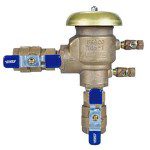- Written by water

What is sewer backflow?
Sewer backflow is a term used in plumbing for unexpected and unwanted flow of water in reverse direction. Normal plumbing allows wastewater to flow from a home to the city sewer, but backflow is the exact opposite.
What causes sewer backflow?
Sanitary sewers work by the force and principal of gravity. So wastewater flows in the direction of the natural slope of the pipe. This is the main reason that the sewer mains owned and maintained by the city are typically located between 10′ and 15′ deep. In many areas they are much deeper than that. Sewer backflow can be triggered by a number of different situations, some examples follow:
- A blockage (in either a private or city sewer pipe) caused by tree roots, construction mishaps, plumbing system deterioration.
- Insufficient capacity due to residential growth
- Cracks in the pipe
- A back-pitched drain system
- A surcharge due to heavy rain or a large snow melt
Normal and abnormal circumstances
In an office and home plumbing system, blockages are often caused by accumulation of grease, hair, and any physical obstruction in the pipe. It may even include napkins, diapers, cigarette butts, toilet paper, and more. When your sewer pipe is blocked, wastewater has no chance of flowing in the right direction, hence backflow. But the most serious and damage causing sewer backflow conditions occur when a public sewer system becomes surcharged.
What are your responsibilities?
This depends on the city in which you live. The Clean Water Act of 1971 is the governing legislation regarding back flow, and all cities in the United States are guided by that act. Most cities require all commercial properties to have an annual backflow test conducted. In addition, all residential properties with an irrigation system are usually required to have similar backflow inspection. The testing is conducted by a select few trained, licensed, and certified backflow testing companies, and the Public Works Department in your city will have a list of those backflow testing companies.
Testing is then conducted by that company and any repairs to the system on your backflow prevention device, if needed, are carried out. The backflow testing company will then fill out the appropriate forms with the city and keep you updated on the city records. They will also notify you when your annual testing is once again due.
Should you be concerned? Not really! Backflow has been around as long as there have been sewer systems in cities. Backflow prevention is commonplace today, and rarely does a situation occur where residents are in any danger. But it does happen, and knowing how the system works if a big step in the right direction.
If you have any questions you can call (817) 996-2000. We are City Backflow Testing, and we service most of the Greater Fort Worth area. Backflow is our business. It is not a terribly glamorous business, but we are experts at it and we can answer any questions or concerns you might have about your backflow prevention system. Give us a call and we will set your mind at ease.
Posted in Backflow Prevention

